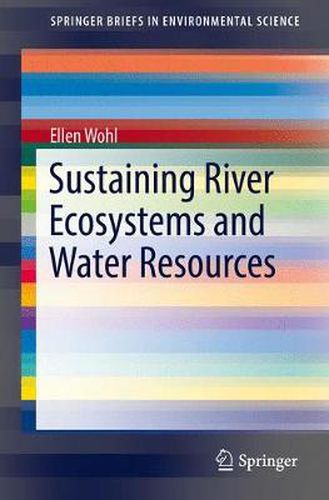Readings Newsletter
Become a Readings Member to make your shopping experience even easier.
Sign in or sign up for free!
You’re not far away from qualifying for FREE standard shipping within Australia
You’ve qualified for FREE standard shipping within Australia
The cart is loading…






This title is printed to order. This book may have been self-published. If so, we cannot guarantee the quality of the content. In the main most books will have gone through the editing process however some may not. We therefore suggest that you be aware of this before ordering this book. If in doubt check either the author or publisher’s details as we are unable to accept any returns unless they are faulty. Please contact us if you have any questions.
This work is designed to broaden the scope with which many people regard a river. Rivers are commonly regarded from a very simplistic perspective as conduits for downstream flows of water. In this context, it may be considered acceptable and necessary to engineer the channel to either facilitate such flows (e.g., channelization, levees) or limit flows and store water (e.g., water supply reservoirs, flood control). The book presents the concept of a river as a spatially and temporally complex ecosystem that is likely to be disrupted in unexpected and damaging ways by direct river engineering and by human activities throughout a drainage basin.
Viewing a river as a complex ecosystem with nonlinear responses to human activities will help to promote a more nuanced and effective approach to managing river ecosystems and to sustaining the water resources that derive from rivers. In this context, water resources refers to ecosystem services including water supply, water quality, flood control, erosion control, and riverine biota (e.g., freshwater fisheries). Chapters in this book draw extensively on existing literature but integrate this literature from a fresh perspective. General principles are expanded upon and illustrated with photographs, line drawings, tables, and brief, site-specific case studies from rivers around the world.
$9.00 standard shipping within Australia
FREE standard shipping within Australia for orders over $100.00
Express & International shipping calculated at checkout
This title is printed to order. This book may have been self-published. If so, we cannot guarantee the quality of the content. In the main most books will have gone through the editing process however some may not. We therefore suggest that you be aware of this before ordering this book. If in doubt check either the author or publisher’s details as we are unable to accept any returns unless they are faulty. Please contact us if you have any questions.
This work is designed to broaden the scope with which many people regard a river. Rivers are commonly regarded from a very simplistic perspective as conduits for downstream flows of water. In this context, it may be considered acceptable and necessary to engineer the channel to either facilitate such flows (e.g., channelization, levees) or limit flows and store water (e.g., water supply reservoirs, flood control). The book presents the concept of a river as a spatially and temporally complex ecosystem that is likely to be disrupted in unexpected and damaging ways by direct river engineering and by human activities throughout a drainage basin.
Viewing a river as a complex ecosystem with nonlinear responses to human activities will help to promote a more nuanced and effective approach to managing river ecosystems and to sustaining the water resources that derive from rivers. In this context, water resources refers to ecosystem services including water supply, water quality, flood control, erosion control, and riverine biota (e.g., freshwater fisheries). Chapters in this book draw extensively on existing literature but integrate this literature from a fresh perspective. General principles are expanded upon and illustrated with photographs, line drawings, tables, and brief, site-specific case studies from rivers around the world.